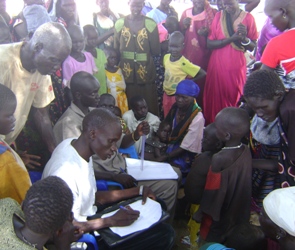42 people killed in Mundari – Bor clashes, displaced need relief assistance
By Philip Thon Aleu
October 7, 2009 (BOR) – At least 42 people are killed, 70 others injured following nearly a week-long fighting between Mundari and Bor youth, officials figures indicate. While 8,000 internal displaced persons (IDPs) are at the augury of starvation in Terekeke and Pariak in Terekeke and Bor Counties respectively and in dire need for humanitarian assistance.
 7,000 Mundari children and women are assembled in Terkeke town, the headquarters of Terkeke County Central Equatoria state (CES), Commissioner Juma Ali Malou told the Sudan Tribune by phone on Wednesday.
7,000 Mundari children and women are assembled in Terkeke town, the headquarters of Terkeke County Central Equatoria state (CES), Commissioner Juma Ali Malou told the Sudan Tribune by phone on Wednesday.
Mr. Malou also named 16 villages burnt at the eastern bank of River Nile and along Juba – Bor road. Earlier unsubstantiated reports estimated devastated villages at 21.
Of the dead 5 are SPLA soldiers, 16 on Bor’s side and 21 die from Mundaris’, officials says. 9 soldiers, 21 from Bor youths and 48 others from Mundari’s, officials say.
The locations assaulted by Bor youths, according to Mr. Malou along Juba – Bor road are Wanyang, Liele, Kuor-ajik, Tejwieri, Palur, Jai, Palek, Paker, Diar, Boku, Bojo, Boso (Ajut), Yabisak, Bambari, Gemeiza and Sudan Safari. These areas span a distance of about 64 kilometers (40 miles) along eastern bank of the River Nile and linear with Juba – Bor road.
From Bor town, an hour drive took this scribe to Pariak Boma center on Bor – Juba road and about 32 kilometers (20 miles on Wednesday. Local leaders say 1,400 IDPs are hosted temporary under trees. A tartaric tree in this location serves as a registration office for South Sudan Relief and Rehabilitation Commission (SSRRC) officials. Alier Pach, a SSRRC officer taking assessment of IDPs here, told the Sudan Tribune that a total of 196 households are recorded. With an average of 5 persons per household, a total of 480 people could have being displaced. Since registration began late Wednesday, less than half is known and the numbers could increase. After the assessment, SSRRC will copy the document to UN for humanitarian assistance, Mr. Alier said.
Though the cause of the latest feuding between Mundari and Bor cattle keeping youths could not be independently verified, livestock play a significant role. Children, women and elderly people are always victims of these clashes common across south Sudan.
SPLA sources in Juba said the clash started when Mundari farmers protested against Dinka Bor cattle that they claimed were let loose into the Mundari peanut farms.
However, a Paramount chief in Pariak accused Mundari counterparts of lack of governance. Beer Ngong-majuot, the head chief says “we agreed compensations for murdering and theft cases but Mundari chiefs not shown responsibility.” He indicated paying back 20 cattle when youth from Pariak (in Bor County) stole some cattle from Mundari last year. Mr. Nong-majuot charged Mundari inhabiting eastern bank of the River Nile of ambushing public vehicles and random killing including four children gunned asleep in Pariak on July 2, 2009. Mundari chiefs cannot be reached for comments.
The contest continues periodically on Tuesday but a noticeable calm is restored today Wednesday. Sudan People’s Liberation Army Division 8 Commander Gen. Bol Kong toured Bor – Juba road on Wednesday but could not be reached for comment by press time. However, public transport shut since Saturday last week.
The next focus for government is how to assist the victims of this conflict. Thousands are displaced from their homes in Mundari villages and others from cattle camps where milk serves as primary food item for children. In Pariak, children are disturbing their mothers to bring milk. In Terkeke, Mundari people confined there could not taste last season harvests from groundnuts and peanut farms.
“The IDPs are totally malnourished,” Commissioner Ali Malou said by phone from Terkeke where allegedly 7,000 people took shields in the western bank of the River Nile.
“Because of this [malnutrition], one elderly-male IDP died this morning. The County cannot feed them. We don’t have that capacity,” Mr. Malou added in a reference to appeal for humanitarians support.
When asked to speak about security on ground based on crude reports, Mr. Malou says “[South Sudan] forces are doing very well and it’s calm.” He, however, observed that “it’s difficult to reach those youth because they are very hostile.” This means, a said directive from CES Gov. Clement Wani Konga to cease hostilities “immediately” will meet some resistance.
In Bor County, Commissioner Maker Lual Kuol told reporters on Monday that his County aims at accelerating the movement of cattle camps stationed in Wuor-bar toward Bor territory. However, the repeated ensnaring of vehicles carrying civilians by marauding Mundari youth has failed this alternative, he says.
“Movement of families [from cattle camps in Wuor-bar to Bor County territory] is a problem because trucks drivers are scared,” he said adding that “when they move, they are attacked.” “Mundari ambush them not only to kill but to take animals.”
Government of South Sudan responded by sending 200 troops on Sunday only to be overwhelmed by armed civilians. As military presence beep up on Juba – Bor road, the tension capsizes. Once the feuding cease, a high level team composed of South Sudan Interior Minister Gier Chuang Aluong, Jonglei Gov. Kuol Manyang Juuk and CES Gov. Clement Wani Konga will launch an investigation to bring perpetrators to books, Sudan Tribune has learnt.
(ST)
